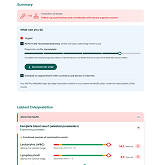Patient story
The information that saved Oliver’s life
Knowledge received in time can save health and life.

Context
45-year-old Oliver had been feeling increasingly unwell over the past few weeks – persistent fatigue, intermittent fevers, and a general sense that something wasn’t right. When he noticed several small, round lumps under the skin on his neck, he finally decided to see his doctor.
His physician took his symptoms seriously and immediately ordered blood work. However, the earliest available follow-up appointment wasn’t until the following week. When Oliver’s lab results came back, he noticed his white blood cell count was significantly elevated.
Now Oliver faced an anxious dilemma: wait until his scheduled appointment next week, or try to understand what these results might mean? The elevated white blood cells, combined with his ongoing symptoms, left him feeling uneasy about waiting several more days without answers.
Rather than spend the weekend worrying or searching for medical information online, Oliver decided to get his results professionally interpreted to understand whether this was something that could wait or required more immediate attention.
See the interpretation of Oliver’s results
Expert commentary
The blood count showed increased concentration of leukocytes (white blood cells), which in combination with symptoms such as persistent fever and enlarged lymph nodes may indicate hematological disorders and require further diagnostics.
In such cases, a manual blood smear – microscopic examination – is essential, which can significantly accelerate proper diagnosis.
Doctor of Medicine, graduate of Pomeranian Medical University in Szczecin, specialized in internal medicine. Works for the Lower Silesian Oncology Centre in Wroclaw, Poland.
Conclusion
The interpretation helped Oliver understand that his results warranted more urgent attention. He did the right thing and had the recommended additional tests performed immediately.
Armed with this knowledge, he contacted his doctor’s office, secured an earlier appointment. This proactive approach led to a timely diagnosis of chronic lymphocytic leukemia at his first visit, allowing his doctor to promptly initiate appropriate treatment.
Oliver’s case demonstrates that sometimes initial lab results are just the beginning of the diagnostic process – additional specialized tests are often necessary to reach a definitive diagnosis and ensure proper patient care.




